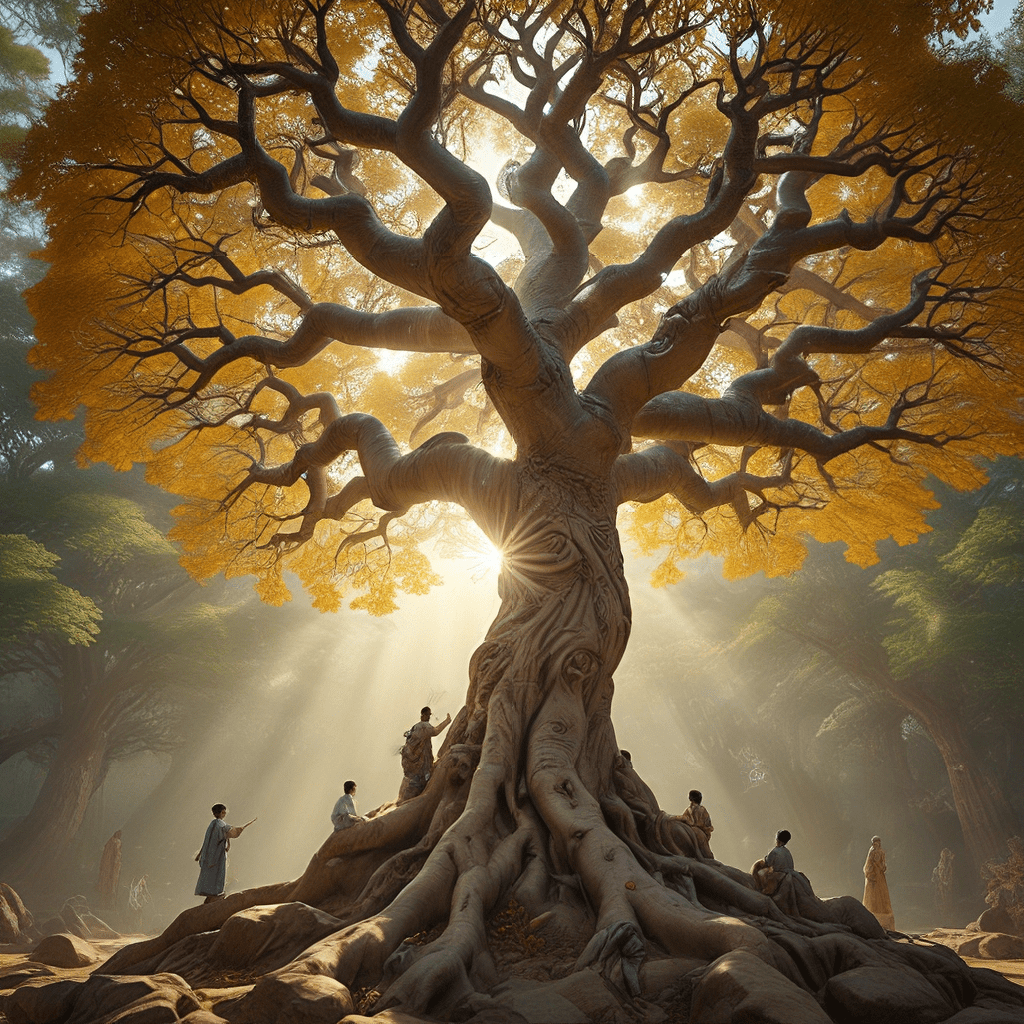Korean Mythology: Unraveling the Legend of the Tree of Life
Overview of Korean Mythology
Korean mythology, a rich tapestry of stories and beliefs, has captivated imaginations for centuries. It is an intricate blend of ancient shamanistic traditions, Buddhist influences, and Confucian ideals, woven together to form a unique and vibrant cultural heritage. These myths, passed down through generations, offer insights into the Korean worldview, values, and understanding of the universe.
These narratives are often infused with spiritual significance, exploring themes of creation, life, death, and the interconnectedness of all beings. They feature a diverse range of deities, mythical creatures, and legendary heroes who embody different aspects of the natural world and human nature.
From the benevolent mountain spirit, San Shin, to the mischievous goblin, Dokkaebi, Korean mythology is populated with characters that both awe and entertain. These stories often provide moral lessons, highlighting the importance of respect for nature, reverence for ancestors, and the pursuit of harmony.
The Tree of Life: A Central Symbol in Korean Folklore
At the heart of Korean mythology lies the enduring symbol of the Tree of Life, a powerful and multifaceted archetype that resonates deeply with the Korean cultural consciousness. This mythical tree, known in Korean as "Seonmu" or "Seonmuk," stands as a testament to the interconnectedness of life, the cyclical nature of existence, and the profound respect for nature that permeates Korean culture.
The Tree of Life appears in various forms throughout Korean folklore, often depicted as a majestic, ancient tree with vibrant foliage and roots that reach deep into the earth. It is a symbol of longevity, abundance, and spiritual growth. But beyond its literal representation, the Tree of Life embodies deeper philosophical and spiritual meanings.
The Tree of Life in Shamanistic Practices
Shamanism, a fundamental aspect of Korean tradition, plays a pivotal role in shaping the understanding and significance of the Tree of Life. Korean shamans, known as "Mudang," believe that the Tree of Life serves as a bridge between the human and spirit worlds. They often perform rituals under the boughs of ancient trees, seeking guidance and blessings from the spirits that reside within them.
The Tree of Life, for the Mudang, is a sacred space where the veil between worlds thins, allowing them to communicate with spirits and access divine knowledge. They believe that the Tree of Life holds the secrets of healing, prosperity, and spiritual enlightenment. Its branches, leaves, and roots are considered powerful conduits for energy and spiritual connection.
The Tree of Life in Korean Literature and Art
The Tree of Life appears prominently in Korean literature and art, serving as a recurring motif that speaks to its enduring cultural significance. From ancient folktales to modern novels, the Tree of Life has captured the imagination of Korean artists and writers, inspiring them to explore its rich symbolism and metaphorical potential.
In traditional Korean paintings, the Tree of Life is often depicted as a centerpiece, symbolizing harmony, balance, and the interconnectedness of life. Its elegant branches and leaves, reaching towards the heavens, represent aspirations for spiritual growth and enlightenment. The Tree of Life also features prominently in Korean poetry, where it is often used to convey themes of nature, beauty, and the passage of time.
The Tree of Life: A Symbol of Connection and Harmony
At its core, the Tree of Life is a profound symbol of connection and harmony. Its roots, firmly planted in the earth, represent the link between humanity and nature. Its branches, reaching towards the heavens, symbolize our aspirations for spiritual growth and connection to the divine. The Tree of Life is a reminder that all beings are interconnected, part of a larger web of life.
This symbol encapsulates the Korean philosophy of "Han," which emphasizes the interconnectedness of all things and the importance of living in harmony with nature. The Tree of Life, with its intricate network of roots, branches, and leaves, serves as a visual metaphor for this interconnectedness, reminding us that our actions have consequences and that we are all responsible for the well-being of the world around us.
The Tree of Life: A Source of Immortality
In Korean mythology, the Tree of Life holds the potential for immortality, a potent symbol of eternal life and renewal. This concept often manifests in stories where humans seek the fruit or sap of the Tree of Life, believing it grants them a life beyond the boundaries of mortality. This pursuit of immortality underscores the human desire to transcend the limitations of time and experience eternal existence.
The Tree of Life's association with immortality echoes the broader theme of longevity in Korean culture. Reverence for ancestors and family lineage is deeply embedded in Korean values. The belief in a continued existence beyond death, often linked to the cycle of reincarnation, reinforces the significance of longevity.
The Tree of Life, in its ability to bestow immortality, represents the ultimate expression of this deep-seated yearning for a life that transcends time and continues beyond the physical realm.
The Tree of Life: A Representation of the Cosmic Axis
Often depicted as a towering tree with branches reaching towards the heavens and roots extending deep into the earth, the Tree of Life serves as a powerful representation of the cosmic axis, connecting the three realms of heaven, earth, and the underworld. It symbolizes the interconnectedness of all existence.
This concept of a cosmic axis resonates with the Korean understanding of the universe as a harmonious whole. The Tree of Life, standing as a bridge between these realms, underscores the importance of balance, order, and the interconnectedness of all things. It embodies the idea that everything in the universe is linked, from the smallest grain of sand to the vastness of the cosmos.
Similar to other cultures' depictions of world trees, the Korean Tree of Life embodies the interconnectedness of the natural world, the human realm, and the spiritual realm. It represents a cosmic order and the interconnectedness of all things, both material and spiritual.
Theories on the Origin of the Tree of Life Myth
The origin of the Tree of Life myth in Korean mythology, like many ancient myths, is rooted in a combination of cultural beliefs, observations of nature, and the human search for meaning.
One theory suggests that the Tree of Life myth emerged from the Korean people's deep reverence for nature, particularly for ancient trees. These trees, often considered sacred, were seen as embodiments of longevity, wisdom, and a connection to the spiritual world.
Another theory suggests that the myth arose from shamanistic practices, where trees were considered portals to the spirit world. Korean shamans would often perform rituals under the boughs of ancient trees, seeking guidance and blessings from the spirits that resided within them.
The Tree of Life, as it evolved through these cultural influences, became a symbol of interconnectedness, spiritual growth, and the pursuit of immortality.
The Tree of Life Myth: A Reflection of Korean Cultural Values
The enduring power of the Tree of Life myth in Korean culture stems from its ability to embody core values and beliefs. It reflects the deep respect for nature, reverence for ancestors, and the pursuit of harmony that are deeply ingrained in Korean tradition.
The Tree of Life's emphasis on interconnectedness, both within the natural world and between humanity and the divine, aligns with the Korean philosophy of "Han." This philosophy emphasizes the importance of living in harmony with nature and understanding the interconnectedness of all things. The Tree of Life, with its roots, branches, and leaves, serves as a visual metaphor for this interconnectedness, encouraging a sense of responsibility for the well-being of the world around us.
The Tree of Life: A Timeless Symbol of Life and Renewal
The Tree of Life, in its enduring presence within Korean mythology, serves as a powerful symbol of life, renewal, and the hope for a future beyond the limitations of mortality. Its cyclical nature, with leaves that fall and bloom anew, embodies the constant flow of life and the promise of rebirth.
The Tree of Life stands as a testament to the resilience and strength of life, reminding us that even in the face of adversity and change, the cycle of life continues. It is a symbol of hope, reminding us that within the cycle of life, there is always the potential for renewal and growth.
Frequently Asked Questions (FAQ)
Q: What is the Tree of Life in Korean mythology?
A: The Tree of Life, known as "Seonmu" or "Seonmuk" in Korean, is a central symbol in Korean mythology that embodies longevity, abundance, spiritual growth, and the interconnectedness of life. It is often depicted as a majestic, ancient tree with vibrant foliage and roots that reach deep into the earth.
Q: What is the significance of the Tree of Life in shamanism?
A: Korean shamans believe the Tree of Life serves as a bridge between the human and spirit worlds. They perform rituals under ancient trees to seek guidance and blessings from the spirits that reside within them.
Q: How is the Tree of Life depicted in Korean literature and art?
A: The Tree of Life appears prominently in Korean literature and art as a recurring motif that symbolizes harmony, balance, and the interconnectedness of life. It is often depicted as a centerpiece in traditional Korean paintings.
Q: What are some theories about the origin of the Tree of Life myth?
A: Theories suggest the myth originated from the Korean people's reverence for ancient trees, shamanistic practices, and the desire for immortality.
Q: What are the cultural values reflected in the Tree of Life myth?
A: The Tree of Life embodies core Korean values like respect for nature, reverence for ancestors, and the pursuit of harmony with nature. It reflects the interconnectedness of all things, as expressed in the Korean philosophy of "Han."
Q: What is the overall significance of the Tree of Life myth?
A: The Tree of Life is a powerful symbol of life, renewal, and hope for a future beyond the limitations of mortality. It reminds us that even in the face of adversity, the cycle of life continues, and there is always the potential for growth and renewal.



